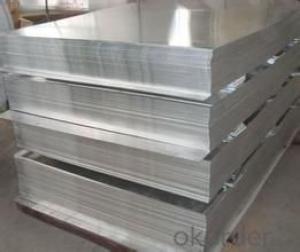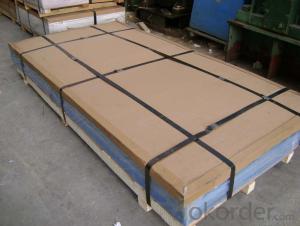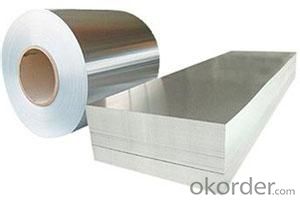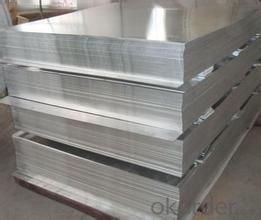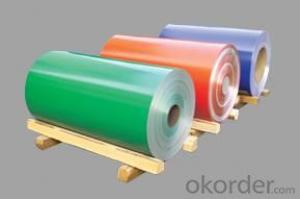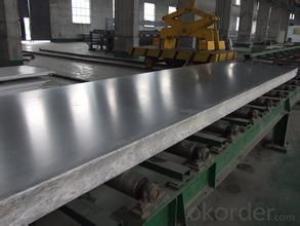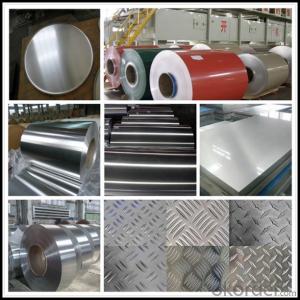Adhesive Aluminum Foil Sheets - Alu Sheet, Strip, Plate Hot Wholesale in China
- Loading Port:
- China Main Port
- Payment Terms:
- TT OR LC
- Min Order Qty:
- -
- Supply Capability:
- -
OKorder Service Pledge
OKorder Financial Service
You Might Also Like
Aluminium is a relatively soft,durable, lightweight, ductile and malleablemetal with appearance ranging from silvery to dull gray,depending on the surface roughness. It is nonmagnetic and does not easilyignite. A fresh film of aluminium serves as a good reflector (approximately92%) of visible light and an excellent reflector (as much as98%) of medium and far infrared radiation. The yield strength of pure aluminium is 7–11 MPa,while aluminium alloys have yield strengths ranging from200 MPa to 600 MPa. Aluminium has about one-third the density and stiffnessof steel. It iseasily machined,cast, drawn and extruded.
Alu Plate
Alloy: AA1050, 1060, 1100, AA3003, 3005, 3015, 5052, 5754, 5083,8011,etc
Temper:H14/16/18/22/24/32,HO etc.
Thickness:0.2mm—100mm
Width:100mm—2300mm (Can be slitted)
Application: Foil stock, Circles, Roofing, Canstock, Marine plate,Anti-sliperypurpose in vehicles, packing and appliance.
Features:
1. Excellent quality of products
2. Quick delivery
3. Best service to clients
4. BV,SGS avalible
5. No buckle o waveness
6. Tension leveling
7. Certificate of Origin
8. Form A,E
Packaging Detail: Carton ,Wooden pallet with plastic protection packing,standard seaworthy packing or as your request.
ProductionCapacity:
AnnualProduction capacity of 600,000 tons.
Products areexported to United States, Canada, U.A.E, Brazil, Mexico,Thailand, Vietnam,Nigeria etc, over 100 countries andregions all over the world.
Coveredfactories with full production line
CNBM aluminumproduction base is comprised of 18 aluminumannealers, 10 coil and foilmills, 4 continuous production lines, 2hot rolling production line and 3prepainted lines.
FAQ:
1. What is the form of payment?
Normally 30% TT, L/C
2. Type of quotation?
FOB, CFR, CIF
3. Port of loading?
Shanghai port
4. Delivery time?
30 day after client’s deposit
- Q: could aluminum sheet be attracted by magnet?
- no, it couldn't.
- Q: Can aluminum sheets be used for solar panels?
- Solar panels can indeed utilize aluminum sheets. Aluminum is widely employed in the manufacturing of solar panels due to its exceptional properties. Its lightweight nature, durability, and resistance to corrosion make it well-suited for enduring diverse weather conditions. Moreover, aluminum boasts excellent electrical conductivity, a crucial element for efficient energy generation in solar panels. By incorporating aluminum sheets, solar panels can guarantee longevity and optimal performance, all while diminishing the panels' overall weight and cost.
- Q: What are the different types of alloys used for painted aluminum sheets?
- There are various types of alloys used for painted aluminum sheets, including the commonly used 3003 and 5052 alloys. These alloys offer excellent corrosion resistance and formability, making them suitable for a wide range of applications. Additionally, other alloys such as 6061 and 7075 are utilized for their high strength properties in more demanding or specialized applications.
- Q: Is it possible to manufacture furniture using aluminum sheets?
- <p>Yes, aluminum sheets can be used to make furniture. Aluminum is a lightweight, durable, and corrosion-resistant material, making it suitable for various furniture applications. It is commonly used in outdoor furniture, such as patio sets, as well as in modern indoor furniture designs. Aluminum furniture is easy to maintain, has a sleek appearance, and can be an eco-friendly choice due to its recyclability.</p>
- Q: Where does China make aluminum plate?
- In many parts of the country have aluminum factory, the old state-owned enterprises have 101, SWA aluminum plant, located in the southwest, northeast china. The emerging aluminum processing base in Henan, due to resource advantages, the largest aluminum factory, the price is relatively low.
- Q: What type of aluminium sheet is a food grade?
- You can inquire about our company: dexincheng Pioneer Metals corporation. Baidu will find the phone soon.
- Q: i want to build a smelter to recycle aluminum auto parts
- It requires high temperature (933K), and is inefficient for small quantities. Why not just sell it to your local recycler?
- Q: What type of aluminum plate does the traffic sign use? 1100?
- Formulated according to unused specifications and design requirements. May refer to the road traffic sign and the marking establishment standard execution.
- Q: Can the aluminum sheets be used for printing applications?
- Aluminum sheets are indeed suitable for printing applications. Thanks to their smooth and flat surface, aluminum is an excellent choice for printing graphics, images, and text. Various printing methods, including offset printing, screen printing, and digital printing, can be effortlessly employed on these sheets. When opting for aluminum sheets for printing, one can expect durability, resistance against fading and weathering, as well as a polished and sophisticated look. Industries such as advertising, automotive, aerospace, and packaging frequently utilize aluminum sheets for signage, labels, nameplates, and decorative purposes.
- Q: Can aluminum sheets be used for protective barriers?
- Aluminum sheets are indeed suitable for protective barriers. Being both lightweight and durable, aluminum possesses exceptional strength and corrosion resistance. Its utilization is widespread across a multitude of contexts necessitating protection, such as construction sites, industrial facilities, and military installations. By effortlessly undergoing fabrication and shaping, aluminum sheets can be transformed into robust barriers that effectively impede unauthorized access and offer protection against potential hazards. Furthermore, aluminum demonstrates remarkable versatility as it can be combined with materials like glass or steel to heighten its protective capabilities. All in all, due to their strength, durability, and versatility, aluminum sheets represent a dependable choice for protective barriers.
Send your message to us
Adhesive Aluminum Foil Sheets - Alu Sheet, Strip, Plate Hot Wholesale in China
- Loading Port:
- China Main Port
- Payment Terms:
- TT OR LC
- Min Order Qty:
- -
- Supply Capability:
- -
OKorder Service Pledge
OKorder Financial Service
Similar products
Hot products
Hot Searches
Related keywords


